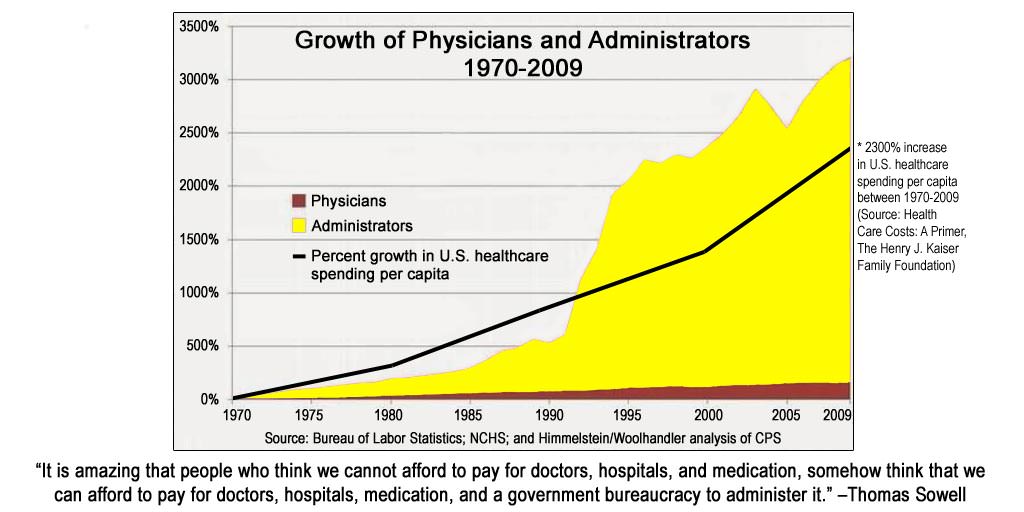|
Many big box medical clinics have high overhead due to their high number of salaried & contracted full-time & part-time administrators. Take a look at the appalling graph below on the growth of administrators vs. physicians over 40 years. See how the growth of administrators is associated with huge increases in healthcare spending and increased cost to you the patient. Direct Primary Care (DPC) clinics are the opposite of big box medical clinics. DPC clinics keep patient costs down by limiting high overhead and the number of administrators. Most Direct Primary Care (DPC) clinics only have one administrator and they pass the cost savings to their patients. Do you want to keep your primary care and healthcare costs down? If so, see the Direct Primary Care (DPC) mapper here to find a DPC clinic near you. Do you want to create demand for more Direct Primary Care clinics in our country? If so, prove the demand here. 
10 Comments
Do you need to sign up for an affordable catastrophic health plan plus an affordable primary care plan during open enrollment Nov 1 - Dec 15? The combination of a Health Share membership plus a membership at a Direct Primary Care clinic like Glover Family Medicine might be a good option for you. Health Shares can reimburse you for mid-range and also catastrophic medical expenses minus your shared amount. Some Health Shares include Sedera, Medi-Share, United Refuah, Samaritan, Zion Health, Liberty HealthShare, Christian Healthcare Ministries.
 When you have an acute medical need like sudden cold or flu symptoms, piercing back pain, or even a weird rash, who should you call first? The answer for many healthcare issues is to call a family physician. The exception to this is, of course, medical emergencies. Medical emergencies require an immediate visit to the emergency room. The problem with this is that the emergency room or urgent care center is the primary source of care for many people. In fact, this is one reason why we as a country spend more on healthcare than anyone else, and why we rank far below the top in overall health. Finding and using a family medicine doctor for you and your family can help this situation. Continue reading for the benefits of having a family physician. 1. Family Doctors Stay With You For Life Family medicine physicians can treat infants, toddlers, children, teenagers and adults. It is not uncommon for a family medicine doctor to see their patients for decades of their lives. Since these physicians have the skills to treat a wide range of medical conditions, they can be your primary care doctor at any point in your life. This helps you build a great relationship with your physician that will last a lifetime. 2. Family Doctors Learn Your History & Your Family History When a doctor is able to treat you for years of your life, they develop a keen understanding of you and your medical history. This helps your doctor to make accurate diagnoses and monitor you more closely for any changes or red flags in your health screenings. In addition to keeping track of your medical history, a family doctor can understand what is happening in their patients’ home lives. For example, if a child’s parent just lost their job, the physician can accurately assess the child’s stress and anxiety. 3. Family Doctors Do More Than Just Yearly Exams While family medicine doctors perform your yearly check-ups, they also are there to help you navigate chronic medical issues such as diabetes, heart disease, asthma and arthritis. They can also treat your acute medical conditions like injuries and many infections, help you through stressful times and keep you well throughout. 4. When You Need a Specialist, They’ll Find The Best One For You Sometimes issues arise that require consultation with or care from a specialist. These can include serious issues like heart disease and cancer. When you or someone in your family develops one of these conditions, your family physician can find someone who fits your exact needs and personality. 5. Family Doctors Improve Lives While Saving Money It should come as no surprise that using more primary care doctors, including family doctors, saves money for individuals and for the healthcare system. In areas of the country where there are more primary care doctors per person, people are less likely to be hospitalized and death rates for cancer, heart disease, and stroke are lower. This was also proven by a study in Rhode Island that showed that a 23% increase in primary care spending resulted in an 18% reduction in overall healthcare spending. A primary care-based system costs less because patients experience better access, fewer hospitalizations, less duplication and more coordinated care. Finding a family doctor for your family’s medical needs could save you and your country money, and more importantly, improve the health of your family.  With all your options for health care, figuring out which doctor to see for your issues can be overwhelming and confusing. Let’s take a look at a couple different types of physicians to help determine which health care provider you should see for gynecological care. Family Physicians often get the question, “What are the differences between the care provided by a gynecologist versus care from a family medicine doctor?” So, what’s the answer? Continue reading to learn some of the differences between the two specialties. A family medicine doctor is best suited for patients outlined below:
The next question many doctors receive is, “When should a young woman begin to seek gynecologic care?” or “At what age should my daughter begin gynecologic visits?” Generally, adolescent girls and young women should visit their family practice doctor for any gynecology concerns between the ages of 11 and 21. An adolescent or young woman who is sexually active should see a physician regularly for pelvic exams or screening tests as soon as she becomes sexually active. In the pre-teen and teen years, a family medicine physician can address the majority of concerns such as:
For the following concerns, a family physician can start the evaluation and refer to another specialist such as a gynecologist or endocrinologist if needed:
Finally, a last common question is, “When should a young woman begin Pap smears for cervical cancer prevention?” Currently, it is recommended that patients begin Pap smear screenings at the age of 21. All female patients should begin at this age, regardless of birth control needs or sexual activity. For further guidance, contact Dr. Jamie Glover at Glover Family Medicine for any health concerns or questions you may have. |
About UsWe love what we do here at Glover Family Medicine. That's why we take time to share our knowledge, whether answering questions about the latest advances in medicine or posting about how we do things at our practice. Archives
November 2017
Categories |

 RSS Feed
RSS Feed